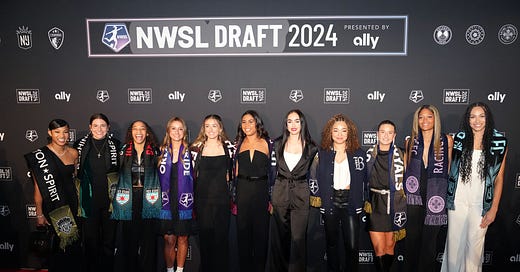Why Did the NWSL Get Rid of the Draft?
Last month, the National Women’s Soccer League announced a new collective bargaining agreement, which will run through 2030. The deal includes a bunch of major victories for players, like a higher minimum salary and an increase in the league’s salary cap. But the thing that interests me the most in this agreement is that the NWSL will become (I believe) the first professional sports league in North America to eliminate its amateur draft. Instead, new players entering the league will simply become free agents, eligible to sign with whichever team they want to play for.
This is excellent news. As I’ve written before, drafts are quite obviously a violation of the rights of players, and they only exist so that owners can suppress player salaries by preventing new players from negotiating with other teams.1 Still, drafts persist because we’ve become so used to them, and in many leagues, The Draft has become such a marketable event that leagues don’t want to kill it and lose the fan interest and revenue that it generates.
So how was the NWSL able to get rid of it? There are a couple obvious reasons. First, the NWSL draft is not exactly a major event, so it probably wasn’t bringing a ton of revenue. The amateur draft was included in the league’s media deal, but apparently it aired on the ION network instead of any major TV channel or streaming service. Forgoing the draft also brings the NWSL in line with the rest of the soccer world, given that club soccer overseas does not operate with a draft. And this isn’t a symbolic connection: League commissioner Jessica Berman said that part of the rationale was that the NWSL hopes to compete for talent globally, and doesn’t want a draft to hinder their ability to sign international players.
But I think another aspect of this is that NWSL is at a crucial moment right now. On the one hand, the league is trying to capitalize on the growth in women’s sports (most obviously in the WNBA). Within the last year, the league signed a major new TV deal and attracted a huge investment from Bob Iger and his wife, which valued its LA-based franchise at $250 million.2 In order to capitalize on these things, the league needed to secure a long-term labor agreement.
On the other hand, the NWSL is still recovering from a series of sexual harassment scandals that drove out the league’s previous commissioner, as well as several coaches. These scandals raised questions about player autonomy — which isn’t unusual, but it was heightened in the case of NWSL, since it’s a women’s league and many of the people in charge are women. As a result, the typical liberal response of bringing in some well-credentialed woman to conduct an investigation and fire some bad men didn’t completely work.
To be clear, they definitely TRIED this strategy, bringing in former Deputy US Attorney General Sally Yates and firing some male coaches. But it was hard to pretend that the issue was a lack of women in prominent positions. And since the women affected were players, the union had to get involved. Indeed, some of the sexual harassment involved just garden-variety employer abuse, like allegedly forging an employee’s signatures on a contract.
In other words, the league has been forced to deal with the fact that sexual harassment IS a labor issue, and that the way to address many labor issues is to increase worker autonomy. In this case, that means letting players pick their own teams. After all, it’s much harder to let cultures of abuse and harassment fester when players have the agency to choose their own workplaces.
The specifics here are probably not replicable in other North American leagues, since other drafts are too high-profile to ditch without serious pushback, and it’s rare for a league to be in such a precarious position as the NWSL is now. But that should not change the lesson that drafts are a labor issue, and that worker power is necessary to combat issues like sexual harassment and discrimination.
Leagues typically defend drafts by saying they are good for parity and competitive balance — there’s some kernel of truth to this, but it’s greatly exaggerated. In most leagues, the salary cap does much more to achieve competitive balance than the draft does. In fact, the draft often undermines parity by encouraging tanking.



